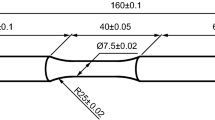Abstract
Fatigue crack growth testing of 2024-T3 Aluminum plate was performed using compact tension (CT) specimens with chromate and non-chromate primer paint systems to evaluate the effects of the coatings on fatigue crack growth rates. The tests were conducted in lab air and sea water environments for each of the coating systems. Standard E399 CT specimens were tested to determine the influence level of environmentally assisted cracking (corrosion fatigue) on crack growth rates and cyclic count to prescribed pre-crack and final crack lengths. Increasing stress range (ΔK) tests were conducted at 10 Hz in the range of 6.5 to 26.5 MPa\(\sqrt m\). It was determined that the coated specimens exhibited a 12% shorter total life, on average, than the bare specimens for the lab air cases. In the case of salt water exposure, the coated specimens exhibited approximately 10% life increase over the bare specimens. The number of cycles to the 2.54 mm pre-crack length for the coated specimens was all less than the cycle count for the bare tests. In each case (coated or bare), there was an increased growth rate at the lower stress ranges in the salt water environment, with the chromate system case displaying the smallest change (increase). It can be concluded that the coated specimens initiate cracks and propagate faster than the bare specimens for short cracks at low stress range, but the environmental influence on the specimens is quickly overshadowed as the cracks elongate and the rate of growth increases. The coated specimens exhibited a higher total life cycle count to final crack length for this testing.














Similar content being viewed by others
References
S.E. Stanzl, H.R. Mayer, and E.K. Tschegg, The Influence of Air Humidity on Near-Threshold Fatigue Crack Growth of 2024-T3 Aluminum Alloy, Mater. Sci. Eng., 1991, A147, p 45–54
G. Henaff, G. Odemer, and A. Tonneau-Morel, Environmentally-Assisted Fatigue Crack Growth Mechanisms in Advanced Materials for Aerospace Applications, Int. J. Fatigue, 2007, 29, p 1927–1940
R. Buchheit, H. Guan, S. Mahajanam, and F. Wong, Active Corrosion Protection and Corrosion Sensing in Chromate-Free Organic Coatings, Prog. Org. Coat., 2003, 47, p 174–182
J. Bennett, Changes in the Influence of Atmospheric Humidity During Fatigue of an Aluminum Alloy, J. Res. Natl. Bur. Stand. C, 1963, 68C(2), p 91–100
A.K. Vasudevan and K. Sadananda, Classification of Environmentally Assisted Fatigue Crack Growth Behavior, Int. J. Fatigue, 2009, 31, p 1696–1708
ASTM, International A Standard Test Method for Measurement of Fatigue Crack Growth Rates, in Designation: E 647 052005: ASTM Headquarters
G.S. Frankel, and R.L. McCreery, Inhibition of Al Alloy Corrosion by Chromates, in The Electrochemical Society InterfaceWinter, The Electrochemical Society, 2001
V. Pokhmurskii, Effect of Chromate and Chromate-Free Organic Coatings on Corrosion Fatigue of an Aluminum Alloy A.F.R.L. (AFOSR), Editor 2012, National Ukrainian Academy of Sciences
C.G. Schmidt et al., Characterization of Early Stages of Corrorion Fatigue in Aircratf Skin S.I. Report, Editor Feb 1996
H.E. Misak, V.Y. Perel, and S.S. Mall, Corrosion Fatigue Crack Growth Behavior of 7075-T6 Under Biaxial Tension-Tension Cyclic Loading Condition, Eng. Fract. Mech., 2013, 106, p 38–48
H.E. Misak et al., Crack Growth Behavior of 7075-T6 Under Biaxial Tension-Tension Fatigue, Int. J. Fatigue, 2013, 55, p 158–165
ASM Handbook, Volume 19, Fatigue and Fracture, (ASM International, 1996), p 800-804
A. Blom, A. Hedlund, W. Zhao, A. Fathulla, B. Weiss, and R. Stickler, Short Fatigue Crack Growth Behavior in Al 2024 and Al 7475, The Behavior of Short Fatigue Cracks, EGF Pub.1 1986, Mechanical Engineering Publications, London, p 37-66.
Acknowledgments
The authors gratefully acknowledge the support of Office of Corrosion Policy and Oversight, OSD, Washington, DC (Mr. Richard A. Hays)
Author information
Authors and Affiliations
Corresponding author
Rights and permissions
About this article
Cite this article
Schubbe, J.J., Westmoreland, S.N. Effects of Chromate and Non-Chromate Coating Systems on Environmentally Assisted Fatigue of an Aluminum Alloy. J. of Materi Eng and Perform 23, 3534–3540 (2014). https://doi.org/10.1007/s11665-014-1159-5
Received:
Revised:
Published:
Issue Date:
DOI: https://doi.org/10.1007/s11665-014-1159-5




